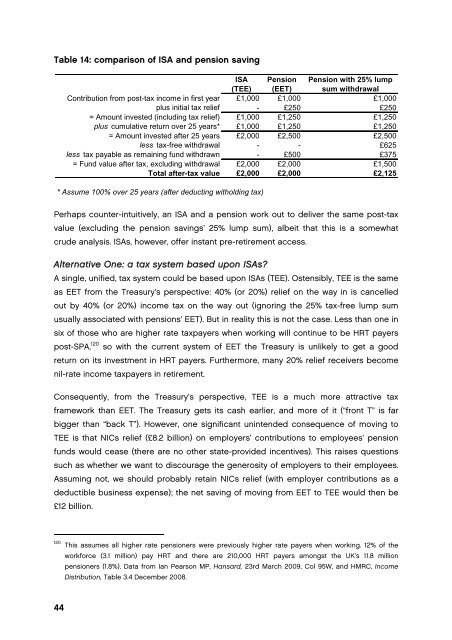Simplification is the key - Centre for Policy Studies
Simplification is the key - Centre for Policy Studies
Simplification is the key - Centre for Policy Studies
Create successful ePaper yourself
Turn your PDF publications into a flip-book with our unique Google optimized e-Paper software.
Table 14: compar<strong>is</strong>on of ISA and pension saving<br />
ISA Pension Pension with 25% lump<br />
(TEE) (EET) sum withdrawal<br />
Contribution from post-tax income in first year £1,000 £1,000 £1,000<br />
plus initial tax relief - £250 £250<br />
= Amount invested (including tax relief) £1,000 £1,250 £1,250<br />
plus cumulative return over 25 years* £1,000 £1,250 £1,250<br />
= Amount invested after 25 years £2,000 £2,500 £2,500<br />
less tax-free withdrawal - - £625<br />
less tax payable as remaining fund withdrawn - £500 £375<br />
= Fund value after tax, excluding withdrawal £2,000 £2,000 £1,500<br />
Total after-tax value £2,000 £2,000 £2,125<br />
* Assume 100% over 25 years (after deducting witholding tax)<br />
Perhaps counter-intuitively, an ISA and a pension work out to deliver <strong>the</strong> same post-tax<br />
value (excluding <strong>the</strong> pension savings’ 25% lump sum), albeit that th<strong>is</strong> <strong>is</strong> a somewhat<br />
crude analys<strong>is</strong>. ISAs, however, offer instant pre-retirement access.<br />
Alternative One: a tax system based upon ISAs?<br />
A single, unified, tax system could be based upon ISAs (TEE). Ostensibly, TEE <strong>is</strong> <strong>the</strong> same<br />
as EET from <strong>the</strong> Treasury’s perspective: 40% (or 20%) relief on <strong>the</strong> way in <strong>is</strong> cancelled<br />
out by 40% (or 20%) income tax on <strong>the</strong> way out (ignoring <strong>the</strong> 25% tax-free lump sum<br />
usually associated with pensions’ EET). But in reality th<strong>is</strong> <strong>is</strong> not <strong>the</strong> case. Less than one in<br />
six of those who are higher rate taxpayers when working will continue to be HRT payers<br />
post-SPA, 120 so with <strong>the</strong> current system of EET <strong>the</strong> Treasury <strong>is</strong> unlikely to get a good<br />
return on its investment in HRT payers. Fur<strong>the</strong>rmore, many 20% relief receivers become<br />
nil-rate income taxpayers in retirement.<br />
Consequently, from <strong>the</strong> Treasury’s perspective, TEE <strong>is</strong> a much more attractive tax<br />
framework than EET. The Treasury gets its cash earlier, and more of it (“front T” <strong>is</strong> far<br />
bigger than “back T”). However, one significant unintended consequence of moving to<br />
TEE <strong>is</strong> that NICs relief (£8.2 billion) on employers’ contributions to employees’ pension<br />
funds would cease (<strong>the</strong>re are no o<strong>the</strong>r state-provided incentives). Th<strong>is</strong> ra<strong>is</strong>es questions<br />
such as whe<strong>the</strong>r we want to d<strong>is</strong>courage <strong>the</strong> generosity of employers to <strong>the</strong>ir employees.<br />
Assuming not, we should probably retain NICs relief (with employer contributions as a<br />
deductible business expense); <strong>the</strong> net saving of moving from EET to TEE would <strong>the</strong>n be<br />
£12 billion.<br />
120 Th<strong>is</strong> assumes all higher rate pensioners were previously higher rate payers when working. 12% of <strong>the</strong><br />
work<strong>for</strong>ce (3.1 million) pay HRT and <strong>the</strong>re are 210,000 HRT payers amongst <strong>the</strong> UK’s 11.8 million<br />
pensioners (1.8%). Data from Ian Pearson MP, Hansard, 23rd March 2009, Col 95W, and HMRC, Income<br />
D<strong>is</strong>tribution, Table 3.4 December 2008.<br />
44

















